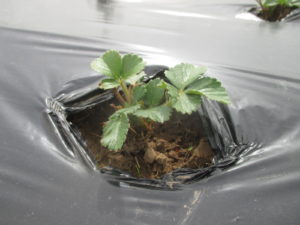In the matted-row system in strawberry production, spring is the time to plant new strawberry patches. Bare-root plants are used in the system. Although you may hear strawberry plugs (actively growing strawberry transplants) are also used as plant materials, plugs are typically not available in the spring. Similar to other bare-root plants, adequate soil moisture is critical for successful plant establishment. Maximum plant growth happens when temperatures are between 59°F to 79°F. Because of the importance of soil moisture and ideal temperature ranges, plant establishment is more difficult if delaying bare-root strawberry planting into the summer.
There is a growing interest of planting day-neutral cultivars for extended season harvest. Day-neutral cultivars are different from June-bearing cultivars, which are typically used in the matted-row system. June-bearing cultivars require short days to initiate flowers, and thus harvest happens in the second year. Day-neutral cultivars develop flowers regardless of day length as long as night temperatures do not exceed 65°F. Under ideal temperatures, day-neutral strawberry plants start to flower right after establishment, and harvest is possible two months after planting. Harvest can be expected in late spring and fall, but not in summer when temperatures are too high (above 80°F) for fruit development. If the goal is to extend harvest with day-neutral cultivars, strawberries should be planted as soon as soil is workable in the spring. There is no need to wait after the last frost passed as strawberry plants can tolerant light frosts.
Bare-root strawberry plants come in bundles of crowns with roots. They should be kept in a shaded area or refrigerator until planting. Ensure the roots are moist. When planting bare-root strawberry plants, it is important to ensure crowns are contacting the soil but not being buried into the soil. Nurseries normally send planting instructions with the plants. It is very important to follow the instructions. Keep in mind that strawberry plants are sensitive to salinity. It is not recommended to put fertilizers in the transplant water. Thoroughly watering soil before and after planting is important. If temperatures are above 80°F at planting, overhead irrigation would be required for successful plant establishment. Under ideal temperature ranges, new leaf growth should be observed about two weeks after planting (Figure 1).
